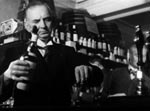






 |
|||||
 |
 |
 |
 |
 |
 |
|
|
Transformation and Continuity"At the end of the 18th century, James Watt of Greenock perfected the rotary steam engine and so released the mineral wealth of the Central area of Scotland. Round the Clyde thundered the new industries; heavy engineering, steel works, forges, foundries, machine shops. From Forth to Clyde the face of the country was utterly changed." "But these people, crowded together in the smoke and sound of the drumming factories were of the same stock as the crofters, the shepherds and the fishermen. Behind every Glasgow family, they say, you will find a croft, a farm, or a fishing village." This sequence shifts between three general spaces; rural crofts, a city pub, and industrial sites. The crofts are silent, in ruins, a gravestone the only sign of the departed human population. The pub and industrial site are noisy, busy and active. The first space is a place of the past, the second and third are places of the present. While the contrast between rural past and industrial present seems absolute, the narration argues otherwise; 'these people, crowded together in the smoke and sound of the drumming factories were of the same stock as the crofters, the shepherds and the fishermen'. The documentary constructs a continuity between these two spaces, a continuity of 'stock'. |
|
Stock is a loose or baggy concept, encompassing source, race and kindred; the crofters, shepherds and fishermen, thrown together as a homogeneous pre-industrial group, are the source of the Scottish race, and therefore the kindred of that other homogeneous group, the 'Scottish industrial workers'. The use of the conceputally vague 'stock' here repeats elision of the difference between race, nationality and culture noted earlier in the documentary's description of 'The land that bred a stern and hardy race'. Similarly, the effect of dissolving, rather than cutting, between the images of the croft ruins and the men in the pub is to assert a continuity between the two sets of images, as a dissolve allows both images to appear on the screen simultaneously. |
|
|
 Still shot of the pub in the transformation and continuity sequence. |
The documentary's production of a specifically national cultural type needs to be understood in terms of what Philip Schlesinger (1991) has referred to as 'the special role of cultural producers as active constructors of national identity' (p. 174). In the construction and maintenance of national identity, he argues, 'history' and 'memory' play a key role: "The elaboration of national identity is a chronic process. Of
considerable importance is the relationship between the present of a national
collectivity and its past. That relationship should be understood, at
least in part, as an imaginary one, mediated by the continual, selective
reconstitution of 'traditions' and of 'social memory'. These categories
direct our attention to the role of cultural institutions and practices
through which the chain of identity between past and present is forged."
(p. 174) |


|
|
| Author: Richard Butt | Images are drawn from the SCRAN database. |